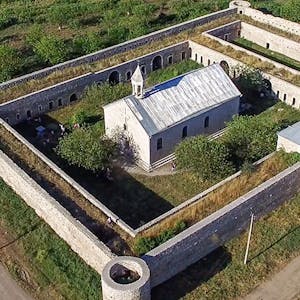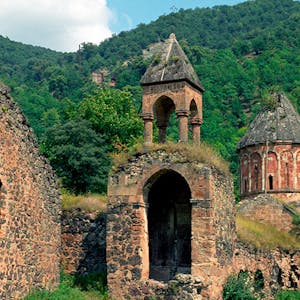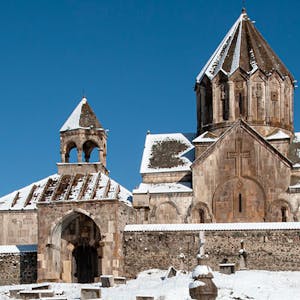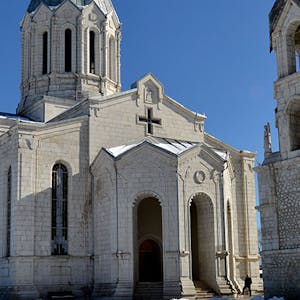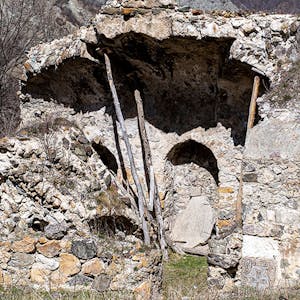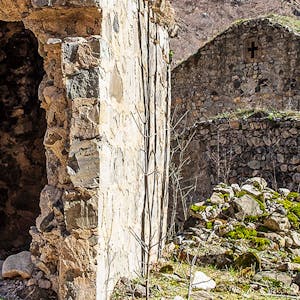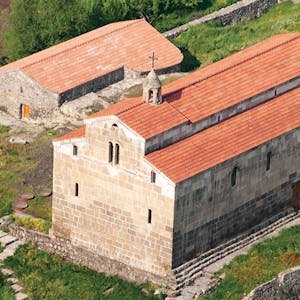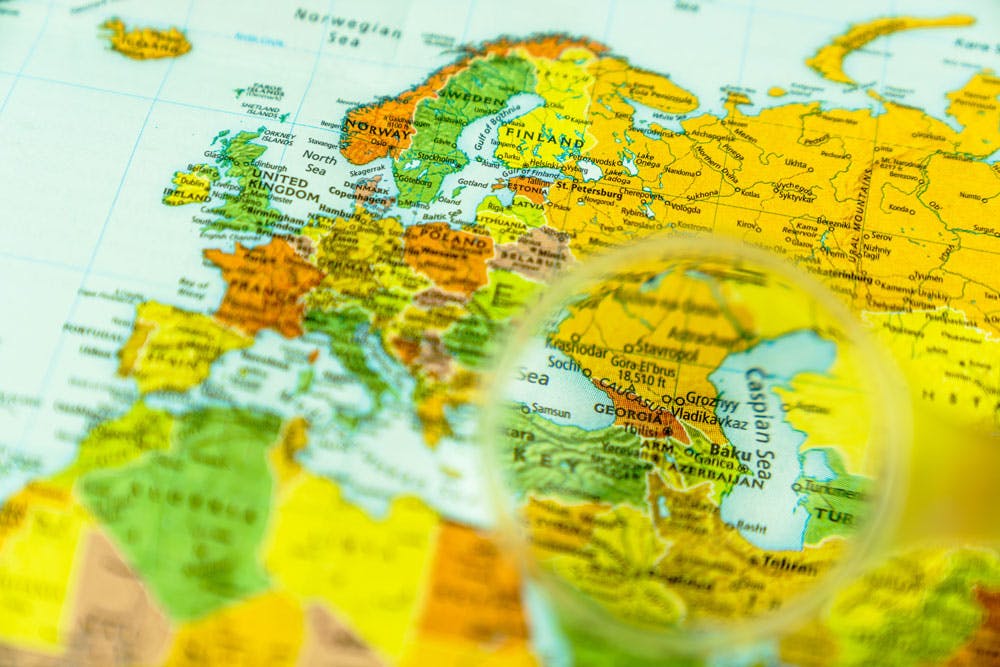
Armenia, which adopted Christianity as its state religion in the early 300s AD, is the world’s first Christian nation. Located at the crossroads of Europe and Asia, between the Black Sea and the Caspian Sea, it holds a vital place in the history of early Christianity. It is an ancient place that is home to a vibrant living faith today.

Karabakh bears traces of the broader history of early Christianity in the region.[1] In the early fourth century, the Armenian, Georgian, and Caucasian Albanian kingdoms each adopted Christianity, forming what could be called a confederation of Christian states; ancient and medieval Armenian writers called them, “The Northern Countries,” in relation to Mesopotamia in the south and the Holy Land to the southeast.[2] As Christianity thrived in this region it created new ties across these nations, an interwoven exchange of cultures and traditions. The people of these lands often read the same books, prayed with similar words, attended the same sacred places in pilgrimage, and venerated common saints and spiritual authorities.
Nestled within that region is the land of Karabakh, known to Armenians as Artsakh. Located in the Armenian Highland, between the Kura and Araxes Rivers, it is a mountainous area that sits at the intersection of modern-day Armenia, Azerbaijan, and Iran.[3] Its hilltops and thick forests provided refuge for Christian communities, helping them survive through centuries of war, conquest, and the sweep of Islamization starting in the seventh and eighth centuries.
Within the Armenian Christian tradition, these communities developed liturgical forms, sacred art, and distinctive architecture that are unique to the land they called home.[4] Today, Karabakh still holds a treasury of churches, monasteries, khachkars (cross-stones), and sacred sites, many of them inscribed in Armenian with the names, stories, and prayers of people from ages past. The monasteries of Karabakh were also home to thriving scriptoria, which produced a wide range of illuminated manuscripts. These manuscripts give us insights into the social and religious life of the Armenian people throughout history.[5]
Christianity and the Armenians
The lands of Greater Armenia have ancient links to the Bible. One of the most familiar is the account of Noah’s ark and its resting place on “the mountains of Ararat” (Genesis 8:4 NRSV).[6] The landing site of the ark is traditionally associated with Mt. Ararat, the towering peak that overlooks the modern nation of Armenia from just across the border with Turkey. From the mountains of Ararat, according to the Bible, humanity was given a second chance, a new beginning that started in this ancient land.
Armenian tradition holds that two of Jesus’s apostles—Jude Thaddeus and Bartholomew—were the first evangelizers to the Armenian people in the first century AD.[7] According to church history, Christianity was adopted as the state religion by decree of King Tiridates the Great in AD 301. Tiridates was himself converted to Christianity by Saint Gregory the Illuminator (Grigor Lusavorich, ca. 257–ca. 331), the patron saint and first official head of the Armenian Apostolic Church. For centuries the Armenian Christian tradition developed distinct forms of liturgy, visual art, literature, and philosophy. It survived a succession of invasions, conquests, and empires, maintaining centuries of unbroken tradition.
In the twentieth century, during the Soviet period, Communist leaders heavily restricted religious worship. They shuttered churches and persecuted the Christian faithful, sending some priests to prison or to exile in Siberia.[8] The churches and monasteries in Karabakh fell into disrepair. Armenian Church leaders protested those policies while finding subtle ways to keep their institution and their communal faith alive.
In 1987, Armenian leaders began to formally petition for the reopening of churches, risking the ire and punishment of the KGB, the Soviet Union’s internal security agency. As the religious revival grew, worshippers held services and baptisms in secret, rekindling the practice of their Christian faith. The collapse of the Soviet Union in 1991 saw a dramatic revival of Christianity and public worship at Karabakh’s sanctuaries. Churches and monasteries were restored and Christian education was revived through teaching at religious centers and Armenian schools.
Today, Armenians are proud their Christian faith outlasted centuries of turbulent history and decades of Soviet oppression. Their dedication gave rise to a flourishing Christianity that is integrated into modern life.
Language
Prior to the fifth century Armenian was only a spoken language. The Armenian people had a rich oral tradition passed down from generation to generation. While the Armenian people had a significant repertoire of literature, it was written using the Greek and Syriac alphabets.
In approximately AD 405, Saint Mesrop Mashtots invented the Armenian alphabet. The subsequent translation of the Bible into Armenian by Saint Mesrop and his students changed the trajectory of Armenian cultural expression forever. The new alphabet marked the beginning of an outpouring of literary production that many scholars describe as the golden age of Armenian literature. The Bibles and religious texts that came out of this rebirth are still, today, some of the defining artifacts of Armenian culture and identity.
For Armenians, the development of the Armenian alphabet is imbued with sacred importance, as it enabled the spread of Christianity, the development of Armenian theology,[9] and the survival of a distinct, unified cultural community.
A History of Conflict
Karabakh, an enclave smaller than the state of Delaware, has been at the center of political and military conflict for centuries. Persians, Romans, Arabs, Parthians, Seljuks, and Mongols all waged battle for control of the region. The mountainous geography of Karabakh gave it some protection, allowing periods of self-rule and centuries of continuous Christian tradition.
By 1923, Armenians made up 94% of the population in Karabakh.[10] In the early years of the Soviet Union, Communist leaders assigned the predominantly Armenian region of Nagorno-Karabakh to the Azerbaijan Soviet Socialist Republic.[11] It was part of a “divide-and-rule” strategy, led by Josef Stalin, that left the Armenian population of Nagorno-Karabakh isolated from their compatriots in Armenia proper.[12]
Nagorno-Karabakh was given special status as an “autonomous oblast,” with a degree of cultural and administrative freedom. But the local Armenian populations complained of ethnic and religious oppression, at several points formally requesting the Kremlin reassign the region to fall within Armenia’s borders.
In 1991, as the Soviet Union was collapsing, the residents of Nagorno-Karabakh held a referendum, voting for independence. Armenians still comprised a vast majority of the population; Azeris in Nagorno-Karabakh boycotted the vote. The ensuing struggles triggered a war between the Armenians and Azerbaijan that saw a tremendous loss of life on both sides, with an estimated 30,000 killed.[13] It also resulted in hundreds of thousands of Azeri refugees left homeless and fleeing the region. In 1994 the guns went quiet. The Armenians declared an independent republic over the land of Karabakh, while controlling seven surrounding territories of Azerbaijan as a buffer zone.
For 26 years after the ceasefire, Armenians built up a small de facto country, unrecognized by any international power but home to an elected government and free civil society. Yet the land still remained legally part of Azerbaijan, leaving major questions unanswered and unsettled: What would be the final political status of this land? What would happen to the Azeri refugees who left at the time of its creation? How would the two sides live together in peace?
After decades of relative calm the conflict reignited in September 2020 with a full-scale war between Azerbaijan and the Armenians in the Republic of Artsakh. The war ended on November 9 after a brutal 44-day conflict. The result was thousands of deaths and the region of Karabakh split: one part under the control of Azerbaijan, the other part remaining with local Armenian officials. It also resulted in many thousands of Armenian refugees left homeless and fleeing the region. Russian peacekeepers would uphold a tense ceasefire, as part of an agreement that would last for up to five years. Beyond that, the long-term status of the region and the people in it is unclear.
In addition to the human toll, the war did extensive damage to cultural and religious heritage sites. After the war, churches, cathedrals, and monasteries almost immediately showed signs of destruction[14] and cultural appropriation.[15] Churches and monuments have disappeared in areas now controlled by Azerbaijan,[16] an ominous step toward the erasure of Armenian culture from the land. Whether these churches and the culture they represent survive, unaltered and intact, is a question that concerns historians and cultural conservationists around the world.
The Risk
This exhibition documents the sacred spaces, religious culture, and personal stories of Armenian people who have lived and worshipped in Karabakh for centuries. It shows these sacred monuments and the traditions they hold as they were up until the September 2020 war.
On October 8, 2020, Azerbaijani missile attacks severely damaged Holy Savior Ghazanchetsots Cathedral. The cathedral had no military value. Photos of the aftermath of the attack show an interior strewn with rubble, broken pews, and damaged art. Three foreign journalists were injured in the attack, and mothers with children had been sheltering in the basement at the time. The ancient city of Tigranakert, with ancient Hellenistic and Armenian remains, was also damaged by shelling.
Religious authorities, archaeologists, and scholars of history around the world were immediately alarmed about the preservation of Armenian cultural heritage in Karabakh.[17] They placed the conflict in the context of a pattern of destruction and appropriation of Armenian culture by Turkey and Azerbaijan.
In the Nakhchivan region of Azerbaijan, thousands of Armenian churches, tombstones, and khachkars (cross-stones) were destroyed, most of them razed to the ground during the period from 1997 to 2006.[18] Researchers documented the destruction of 89 medieval churches, 5,840 cross-stones, and 22,000 tombstones. The American Association for the Advancement of Science, using satellite images to track the destruction of the sites, showed the phased disappearance of Christian monuments in the Djulfa cemetery of Nakhchivan.[19] The researchers found “significant evidence of destruction to Armenian cultural artefacts,” noting that “heavy machinery was likely used in the demolition of the area.”[20] International observers requested access to the sites, hoping to preserve their archaeological treasures, but were denied permission by Azerbaijan.
Almost a century before, during the Armenian Genocide perpetrated by the Ottoman Empire, the predecessor of modern Turkey, an estimated 1.5 million Armenians were massacred or marched to their deaths in a campaign of extermination that ran from 1915 to 1923.[21] Other Christian cultures and peoples, including Syriac and Greek Christians, were also annihilated. The Genocide almost entirely erased a people from their ancestral homeland, leaving only traces of their presence. Thousands of churches, monasteries, and religious objects were destroyed. Some of the remaining churches were physically altered and repurposed as mosques, while others were left in ruins.
Today, in Karabakh, the Christian holy sites of an ancient community are at risk of destruction, alteration, and cultural appropriation. International organizations, such as UNESCO and Blue Shield International, whose missions include the protection of cultural heritage sites are working to document and secure these sites in their present state. UNESCO has proposed sending an independent mission to visit the churches and monasteries of Karabakh—a first step toward their preservation—but has been awaiting permission from Azerbaijan to do so since December 2020.[22] A UNESCO statement affirmed that “the safeguarding of heritage is an important condition for the establishment of lasting peace. We are therefore expecting Baku to respond without delay so that the constructive discussions held over recent weeks can be turned into action.”[23]
His Holiness Karekin II, Supreme Patriarch and Catholicos of the Armenian Apostolic Church, pled for the preservation of the people and culture of Nagorno-Karabakh:
I pray that the world will awaken to this call, standing up to protect this small piece of land and its significant contribution to universal human culture. My people fervently hope that institutions … will play a role in maintaining our sacred sites in the condition they are today. We call on the rest of the world to bear witness, to pray for peace and justice, and perhaps even to go see these churches themselves someday.
